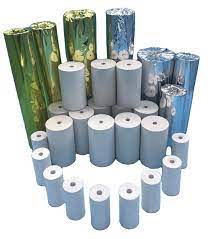In a world dominated by digital advancements, the humble thermal paper roll might seem like a relic of the past. However, this unassuming roll of paper plays a crucial role in various industries, providing a quick and efficient method for printing receipts, labels, and other essential documents. In this article, we will explore the fascinating technology behind thermal paper rolls, shedding light on their composition, applications, and environmental impact. Check out: thermal paper rolls manufacturers
Composition of Thermal Paper:
Thermal paper is coated with a special type of dye and developer that reacts to heat. The paper itself is typically made from a base layer of paper, often lightweight and easily rollable, which is then coated with a layer of chemicals. The key components in the coating are leuco dyes and developers. Leuco dyes are colorless at room temperature but turn into colored forms when exposed to heat, while developers facilitate this color-changing reaction.
How Thermal Paper Printing Works:
The magic of thermal paper lies in its ability to produce images through a simple process. When heat is applied to the thermal paper, perhaps through a thermal printer, the heat activates the leuco dyes in the coating. This causes the dyes to react with the developers, resulting in a visible color change. By controlling the intensity and duration of the heat applied, different shades and patterns can be produced on the paper, allowing for the creation of detailed prints.
Applications of Thermal Paper Rolls:
Thermal paper rolls find extensive use in a variety of applications, primarily due to their convenience, speed, and reliability. Some common uses include:
1. Retail Receipts: Thermal paper is widely used in point-of-sale (POS) systems for printing receipts. The instant printing capability ensures a swift transaction process in busy retail environments.
2. Labels and Barcodes: Thermal printing is commonly employed for generating labels and barcodes, providing a quick and efficient method for inventory management and tracking.
3. Medical Imaging: In certain medical applications, thermal paper is utilized for printing ultrasound images and other diagnostic results. The high-resolution prints aid healthcare professionals in accurate diagnosis.
4. Ticket Printing: Whether it’s for movie tickets, transportation, or event admissions, thermal paper rolls are often the preferred choice for printing tickets due to their speed and clarity.
Environmental Considerations:
While thermal paper offers undeniable advantages in terms of speed and efficiency, there are environmental concerns associated with its use. Traditional thermal paper contains bisphenol A (BPA), a chemical that has raised health and environmental issues. In response to these concerns, there has been a shift towards developing BPA-free thermal paper and exploring alternative technologies that are more environmentally friendly.
Conclusion:
The thermal paper roll, a seemingly ordinary item, hides a world of fascinating technology behind its layers. Its widespread use across various industries attests to its efficiency and reliability in providing instant prints. As technology continues to evolve, it will be interesting to see how the industry adapts to address environmental concerns while maintaining the convenience that thermal paper rolls offer in our fast-paced world.
For more information regarding thermal paper rolls suppliers visit our website: https://www.jflabel.com/


No comments yet